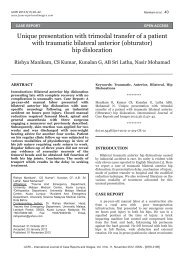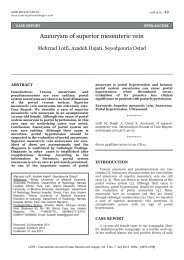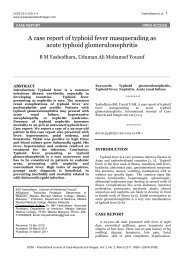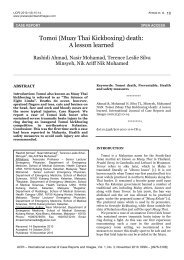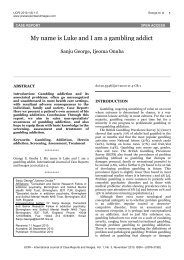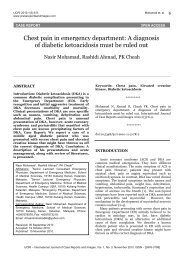The root canal treatment in maxillary and mandibular molars with ...
The root canal treatment in maxillary and mandibular molars with ...
The root canal treatment in maxillary and mandibular molars with ...
You also want an ePaper? Increase the reach of your titles
YUMPU automatically turns print PDFs into web optimized ePapers that Google loves.
IJCRI 201 2;3(5):11 –1 5.<br />
www.ijcasereports<strong>and</strong>images.com<br />
Çiçek et al. 11<br />
CASE SERIES<br />
OPEN ACCESS<br />
<strong>The</strong> <strong>root</strong> <strong>canal</strong> <strong>treatment</strong> <strong>in</strong> <strong>maxillary</strong> <strong>and</strong> m<strong>and</strong>ibular<br />
<strong>molars</strong> <strong>with</strong> five <strong>root</strong> <strong>canal</strong>s: Two case reports <strong>with</strong><br />
two years follow up<br />
Ersan Çiçek, Ebru Özsezer Demiryürek, Semih Özsevik<br />
ABSTRACT<br />
Introduction: One of the most important steps<br />
<strong>in</strong> successful <strong>root</strong> <strong>canal</strong> <strong>treatment</strong> process is to<br />
underst<strong>and</strong> the morphology of the <strong>root</strong> <strong>canal</strong>.<br />
<strong>The</strong>refore, the cl<strong>in</strong>icians should consider <strong>and</strong><br />
release the anatomic variations <strong>in</strong> diagnosis <strong>and</strong><br />
<strong>treatment</strong> of the m<strong>and</strong>ibular <strong>and</strong> <strong>maxillary</strong><br />
<strong>molars</strong>. Case Series: <strong>The</strong> aim of this case series<br />
is to present the successful <strong>root</strong> <strong>canal</strong><br />
<strong>treatment</strong>s completed <strong>in</strong> lower right first molar<br />
<strong>and</strong> <strong>in</strong> upper left first molar. In the first case; <strong>in</strong><br />
right lower first molar five <strong>root</strong> <strong>canal</strong>s were<br />
found, one <strong>root</strong> <strong>canal</strong> was <strong>in</strong> the mesibuccal<br />
<strong>root</strong>, one <strong>root</strong> <strong>canal</strong> was <strong>in</strong> the mesiol<strong>in</strong>gual <strong>root</strong><br />
<strong>and</strong> three <strong>root</strong> <strong>canal</strong>s were <strong>in</strong> the distal <strong>root</strong>.<br />
This <strong>root</strong> <strong>canal</strong> <strong>treatment</strong> was completed <strong>in</strong> one<br />
session. In the second case, five <strong>root</strong> <strong>canal</strong>s were<br />
found, two of them were <strong>in</strong> the mesibuccal <strong>root</strong>,<br />
<strong>in</strong> upper left first molar, two of them were <strong>in</strong> the<br />
distobuccal <strong>root</strong> <strong>and</strong> the fifth was <strong>in</strong> the<br />
palat<strong>in</strong>al <strong>root</strong>. <strong>The</strong> <strong>root</strong> <strong>canal</strong> <strong>treatment</strong> process<br />
was completed <strong>in</strong> three sessions. <strong>The</strong> cl<strong>in</strong>ical<br />
follow up performed after two years revealed<br />
that no symptoms were observed <strong>in</strong> both cases<br />
<strong>and</strong> the teeth were radiographically healthy.<br />
Conclusion: Successful endodontic <strong>treatment</strong><br />
Ersan Çiçek 1 , Ebru Özsezer Demiryürek 1 , Semih<br />
Özsevik 2<br />
Affiliations: 1<br />
Ondokuz Mayis University, Faculty of<br />
Dentistry, Department of Endodontics, Samsun-Turkey;<br />
2<br />
Ondokuz Mayis University, Faculty of Dentistry,<br />
Department of Restorative Dentistry, Samsun-Turkey.<br />
Correspond<strong>in</strong>g Author: Ersan Çiçek, PhD. Ondokuz<br />
Mayis University, Faculty of Dentistry, Department of<br />
Endodontics 551 39, Samsun-Turkey; Ph: +90 362 31 2<br />
1 9 1 9-3002; Email: ersancicek@gmail.com<br />
Received: 24 August 2011<br />
Accepted: 1 4 November 2011<br />
Published: 31 May 201 2<br />
starts <strong>with</strong> proper cl<strong>in</strong>ical <strong>and</strong> radiographic<br />
exam<strong>in</strong>ations. It is important for cl<strong>in</strong>icians to be<br />
aware of all possible anatomic variations for a<br />
good endodontic practice.<br />
Keywords: Anatomic variations, Maxillary <strong>and</strong><br />
m<strong>and</strong>ibular molar teeth, Root <strong>canal</strong> <strong>treatment</strong><br />
*********<br />
Çiçek E, Demiryürek EÖ, Özsevik S. <strong>The</strong> <strong>root</strong> <strong>canal</strong><br />
<strong>treatment</strong> <strong>in</strong> <strong>maxillary</strong> <strong>and</strong> m<strong>and</strong>ibular <strong>molars</strong> <strong>with</strong> five<br />
<strong>root</strong> <strong>canal</strong>s: Two case reports <strong>with</strong> two years follow up.<br />
International Journal of Case Reports <strong>and</strong> Images<br />
2012;3(5):11–15.<br />
*********<br />
doi:10.5348/ijcri201205117CS2<br />
INTRODUCTION<br />
One of the most important steps of a successful <strong>root</strong><br />
<strong>canal</strong> <strong>treatment</strong> process is to underst<strong>and</strong> the<br />
morphology of the <strong>root</strong> <strong>canal</strong>. <strong>The</strong>refore, the cl<strong>in</strong>icians<br />
should consider <strong>and</strong> release the anatomic variations <strong>in</strong><br />
the process of diagnosis <strong>and</strong> <strong>treatment</strong> of the <strong>maxillary</strong><br />
<strong>and</strong> m<strong>and</strong>ibular <strong>molars</strong>.<br />
Ingle et al. [1] stated that one of the ma<strong>in</strong> reasons of<br />
endodontic failure is the <strong>in</strong>complete obturation of the<br />
<strong>root</strong> <strong>canal</strong> system. Hence, the correct location,<br />
biomechanic <strong>in</strong>strumentation <strong>and</strong> hermetic obturation<br />
of all <strong>canal</strong>s are essential procedures.<br />
Mart<strong>in</strong>ez–Berna et al. <strong>in</strong>vestigated the anatomical<br />
configuration <strong>and</strong> the number of <strong>root</strong> <strong>canal</strong>s of the<br />
m<strong>and</strong>ibular <strong>molars</strong> <strong>in</strong> several <strong>in</strong> vitro <strong>and</strong> <strong>in</strong> vivo<br />
studies [2]. <strong>The</strong>y reported 29 teeth <strong>with</strong> five <strong>root</strong> <strong>canal</strong>s<br />
<strong>in</strong> a sample of 2362 m<strong>and</strong>ibular permanent <strong>molars</strong>.<br />
Fabra–Campos [3] studied 145 m<strong>and</strong>ibular first <strong>molars</strong><br />
<strong>and</strong> found that 2.75% of the teeth had five <strong>canal</strong>s. A<br />
IJCRI – International Journal of Case Reports <strong>and</strong> Images, Vol. 3 No. 5, May 201 2. ISSN – [0976-31 98]
IJCRI 201 2;3(5):11 –1 5.<br />
www.ijcasereports<strong>and</strong>images.com<br />
Çiçek et al. 1 2<br />
radiographic study performed on extracted teeth<br />
reported m<strong>and</strong>ibular first <strong>molars</strong> had three mesial<br />
<strong>canal</strong>s <strong>in</strong> 13.3% of specimens, four mesial <strong>canal</strong>s <strong>in</strong> 3.3%<br />
of specimens, <strong>and</strong> three distal <strong>canal</strong>s <strong>in</strong> 1.7% of<br />
specimens [2]. Cl<strong>in</strong>ical evaluations have shown a small<br />
but significant number of m<strong>and</strong>ibular <strong>molars</strong> <strong>with</strong> five<br />
<strong>canal</strong>s [2, 5].<br />
Some authors [6–8] reported that the <strong>in</strong>cidens of a<br />
mesiobuccal (MB) <strong>root</strong> <strong>with</strong> two <strong>canal</strong>s varies between<br />
64% <strong>and</strong> 96 %. However, the <strong>in</strong>cidence of two <strong>canal</strong>s <strong>in</strong><br />
the distobuccal (DB) <strong>root</strong> is unusual. Sert et al. reported<br />
that the <strong>in</strong>cidence of two distobuccal <strong>canal</strong>s was 9.5%<br />
[9]. Quite less frequent is the occurrence of five <strong>canal</strong>s<br />
<strong>in</strong> <strong>maxillary</strong> first <strong>molars</strong>. Gray et al. reported five <strong>canal</strong>s<br />
<strong>in</strong> 2.4% of two mesiobuccal, two distobuccal <strong>and</strong> one<br />
palatal <strong>canal</strong> [10].<br />
<strong>The</strong> aim of this case report is to present two cases<br />
<strong>with</strong> successful <strong>root</strong> <strong>canal</strong> <strong>treatment</strong>s completed <strong>in</strong><br />
lower right first molar <strong>and</strong> upper left first molar. In the<br />
first case five <strong>root</strong> <strong>canal</strong>s were found, one <strong>root</strong> <strong>canal</strong> was<br />
<strong>in</strong> the mesibuccal <strong>root</strong> of lower right first molar, the<br />
other was <strong>in</strong> the mesiol<strong>in</strong>gual <strong>root</strong> <strong>and</strong> three <strong>root</strong> <strong>canal</strong>s<br />
were <strong>in</strong> the distal <strong>root</strong>. This <strong>root</strong> <strong>canal</strong> <strong>treatment</strong> was<br />
completed <strong>in</strong> one session. In the second case, five <strong>root</strong><br />
<strong>canal</strong>s were found, two of them were <strong>in</strong> the mesibuccal<br />
<strong>root</strong> of upper left fist molar, two of them were <strong>in</strong> the<br />
distobuccal <strong>root</strong> <strong>and</strong> the last one was <strong>in</strong> the palat<strong>in</strong>al<br />
<strong>root</strong>. <strong>The</strong> <strong>root</strong> <strong>canal</strong> <strong>treatment</strong> process was completed <strong>in</strong><br />
three sessions.<br />
Brazil). Next, the <strong>root</strong> <strong>canal</strong>s were filled <strong>with</strong> AH plus<br />
(Dentsply, De Trey, Konstanz, Germany) <strong>and</strong> guttapercha<br />
(Dentsply, Maillefer, Brazil <strong>and</strong> Dia–Dent,<br />
Maillefer, Korea) by us<strong>in</strong>g the cold lateral compaction<br />
technique (Figure 3). Upon completion of the <strong>root</strong> <strong>canal</strong><br />
therapy, the tooth was restorated <strong>with</strong> composite res<strong>in</strong><br />
materials (Clearfil APX; Kuraray Medical Inc, Tokyo,<br />
Japan). An 18month postobturation xray confirmed<br />
the success of endodontic therapy (Figure 4).<br />
Case 2: A 22yearsold male patient presented to<br />
Ondokuz Mayis University, Faculty of Dentistry,<br />
Department of Endodontics <strong>with</strong> short <strong>and</strong> discont<strong>in</strong>ous<br />
pa<strong>in</strong> <strong>in</strong> left upper first molar. He gave a history of pulp<br />
capp<strong>in</strong>g <strong>treatment</strong> <strong>and</strong> amalgam fill<strong>in</strong>g <strong>in</strong> the left upper<br />
first molar tooth approximately one year back (Figure<br />
5). When the patient presented to our cl<strong>in</strong>ic<br />
approximately one year later, the patient reported<br />
spontaneous pa<strong>in</strong> <strong>in</strong> the tooth, especially dur<strong>in</strong>g the<br />
night. <strong>The</strong> patient was diagnosed <strong>with</strong> irreversible<br />
pulpitis.<br />
CASE SERIES<br />
Case 1: Dental history was taken from 47yearsold<br />
male patient who presented to Ondokuz Mayis<br />
University, Faculty of Dentistry, Department of<br />
Endodontics, <strong>and</strong> he <strong>in</strong>formed that he had compla<strong>in</strong>t <strong>in</strong><br />
the right lower first molar. <strong>The</strong> patient had no<br />
significant medical history. No caries <strong>and</strong> no restoration<br />
were detected on cl<strong>in</strong>ical <strong>and</strong> radiographic<br />
exam<strong>in</strong>ations. Late response of the tooth to electrical<br />
pulp test was detected. It was concluded that the tooth<br />
could be partially nonvital. Also, there was a<br />
periodontal <strong>in</strong>flamation causedly an angler bone defect<br />
between rigth first molar <strong>and</strong> second molar teeth. <strong>The</strong><br />
patient was referred Department of Periodontology. He<br />
was advised <strong>root</strong> <strong>canal</strong> <strong>treatment</strong> before periodontal<br />
flap <strong>and</strong> bone greft<strong>in</strong>g operation. After a local<br />
anesthetic, ultraca<strong>in</strong>e DS fort (4% artica<strong>in</strong>e <strong>with</strong><br />
ep<strong>in</strong>ephr<strong>in</strong>e 1/100000, HoechstMarion Roussel,<br />
Frankfurt, Germany) was adm<strong>in</strong>istered by m<strong>and</strong>ibular<br />
anesthesia, a rubberdam was placed <strong>and</strong> access cavity<br />
was opened. When the access cavity preparation was<br />
complete <strong>and</strong> pulp tissue was removed, the <strong>canal</strong><br />
orifices were localized easily (Figure 1). Five <strong>root</strong> <strong>canal</strong>s<br />
were detected <strong>in</strong> total, three <strong>root</strong> <strong>canal</strong>s <strong>in</strong> the distal<br />
<strong>root</strong> <strong>and</strong> one each <strong>in</strong> the mesiobuccal <strong>and</strong> mesiol<strong>in</strong>gual<br />
<strong>root</strong>. <strong>The</strong> <strong>root</strong> <strong>canal</strong> <strong>treatment</strong> was completed <strong>in</strong> one<br />
session. Work<strong>in</strong>g length was def<strong>in</strong>ed <strong>with</strong> periapical<br />
radiography (Figure 2). <strong>The</strong> <strong>root</strong> <strong>canal</strong>s were enlarged<br />
up to F3 <strong>with</strong> ProTaper rotary NiTi system (Dentsply,<br />
Figure 1: Work<strong>in</strong>g lenght radiography (Case 1).<br />
Figure 2: Access cavity preparation (Case 1).<br />
IJCRI – International Journal of Case Reports <strong>and</strong> Images, Vol. 3 No. 5, May 201 2. ISSN – [0976-31 98]
IJCRI 201 2;3(5):11 –1 5.<br />
www.ijcasereports<strong>and</strong>images.com<br />
Çiçek et al. 1 5<br />
Conflict of Interest<br />
Authors declare no conflict of <strong>in</strong>terest.<br />
Copyright<br />
© Ersan Çiçek et al. 2012; This article is distributed<br />
under the terms of Creative Commons attribution 3.0<br />
License which permits unrestricted use, distribution <strong>and</strong><br />
reproduction <strong>in</strong> any means provided the orig<strong>in</strong>al authors<br />
<strong>and</strong> orig<strong>in</strong>al publisher are properly credited. (Please see<br />
www.ijcasereports<strong>and</strong>images.com /copyrightpolicy.php<br />
for more <strong>in</strong>formation.)<br />
REFERENCES<br />
16. Friedman S, Moshonov J, Stabholz A. Five <strong>root</strong><br />
<strong>canal</strong>s <strong>in</strong> a m<strong>and</strong>ibular first molar. Endodontics <strong>and</strong><br />
Dental Traumatolog 1986;2:226–8.<br />
17. Quackenbush LE. M<strong>and</strong>ibular molar <strong>with</strong> three<br />
distal <strong>root</strong> <strong>canal</strong>s. Endodontics <strong>and</strong> Dental<br />
Traumatology 1986;2:48–9.<br />
18. Bond JL, Harwell G, Portell FR. Maxillary first molar<br />
<strong>with</strong> six <strong>canal</strong>s. Journal of Endodontics<br />
1988;14:258–60.<br />
19. Hulsmann M. A <strong>maxillary</strong> first molar <strong>with</strong> two<br />
distobuccal <strong>root</strong> <strong>canal</strong>s. Journal of Endodontics<br />
1997;23:707–8.<br />
20. Mart<strong>in</strong>ezBerna A, RuizBadanelli P. Maxillary first<br />
<strong>molars</strong> <strong>with</strong> six <strong>canal</strong>s. Journal of Endodontics<br />
1983;9:375–1.<br />
1. Ingle JI. Endodontics, 3rd edt. Philadelphia, PA:<br />
Saunders 1985.<br />
2. Mart<strong>in</strong>ezBerna A, Badanelli P. <strong>in</strong>vestigación cl<strong>in</strong>ica<br />
de molares <strong>in</strong>feriores con c<strong>in</strong>co conductos. Boletín<br />
de <strong>in</strong>formation Dental 1983;43:27–41.<br />
3. FabraCampos CH. Unusual <strong>root</strong> anatomy of<br />
m<strong>and</strong>ibular first <strong>molars</strong>. Journal of Endodontics<br />
1985;11:568–2.<br />
4. Goel NK, Gill KS, Taneja JR. Study of <strong>root</strong> <strong>canal</strong>s<br />
configuration <strong>in</strong> m<strong>and</strong>ibular first permanent molar.<br />
Journal of Indian Society of Pedodontics <strong>and</strong><br />
Preventive Dentistry 1991;8:12–4.<br />
5. Bueno CE, Cunha RS, Dotto SR, Ferreira R. Um<br />
molar <strong>in</strong>ferior com c<strong>in</strong>co canaiscaso reportado.<br />
Revista da Faculdade de Odontologia da Universida<br />
de Passo Fundo 2002;7:51–3.<br />
6. Caliskan MK, Pehlivan Y, Sepetcioglu F, Türkün M,<br />
Tuncer SS. Root <strong>canal</strong> morphology oh human<br />
permanent teeth <strong>in</strong> a Turkish population. Journal of<br />
Endodontics 1995;21:200–4.<br />
7. Stropto JJ. Canal morphology of <strong>maxillary</strong> <strong>molars</strong>:<br />
Cl<strong>in</strong>ical observations of <strong>canal</strong> configuraitons.<br />
Journal of Endodontics 1999;25:446–50.<br />
8. Kulild JC, Peters DD. Incidence <strong>and</strong> configuraiton of<br />
<strong>canal</strong> systems <strong>in</strong> the mesiobuccal <strong>root</strong> of <strong>maxillary</strong><br />
first <strong>and</strong> second <strong>molars</strong>. Journal of Endodontics<br />
1990;16:311–7.<br />
9. Sert S, Bayirli GS. Evaluation of the <strong>root</strong> <strong>canal</strong><br />
configuraitons of the m<strong>and</strong>ibular <strong>and</strong> <strong>maxillary</strong><br />
permanent teeth by gender <strong>in</strong> the Turkish<br />
population. Journal of Endodontics 2004;30:391–8.<br />
10. Gray R. <strong>The</strong> <strong>maxillary</strong> First molar. In Bjorndal A,<br />
Skidmore E, eds. Anatomy <strong>and</strong> morphology of the<br />
human teeth. Lowa City: University of lowa College<br />
of Dentistry 1983;31–40.<br />
11. V<strong>and</strong>e Voorde HE, Odendahl D, Davis J. Molar 4th<br />
<strong>canal</strong>s: frequent cause of endodontic failure. III.<br />
Dental Journal 1975;44:779–6.<br />
12. Badanelli P, Mart<strong>in</strong>ezBerna A. Obturation de un<br />
molar <strong>in</strong>ferior con c<strong>in</strong>co conductos. In: Lasala A, ed.<br />
Endodonticia. Barcelona: Salvat S A 1979:407.<br />
13. Berthiaume JT. Five <strong>canal</strong>s <strong>in</strong> a lower first molar.<br />
<strong>The</strong> Journal of the Michigan Dent Association<br />
1983;65:213–4.<br />
14. Stroner WF, Remeikis NA, Carr GB. M<strong>and</strong>ibular first<br />
molar <strong>with</strong> three distal <strong>canal</strong>s. Oral Surgery<br />
1984;57:554–7.<br />
15. Beatty RG, Interian CM. A m<strong>and</strong>ibular first molar<br />
<strong>with</strong> five <strong>canal</strong>s: report of case. <strong>The</strong> Journal of the<br />
American Dental Association 1985;111:769–1.<br />
IJCRI – International Journal of Case Reports <strong>and</strong> Images, Vol. 3 No. 5, May 201 2. ISSN – [0976-31 98]



